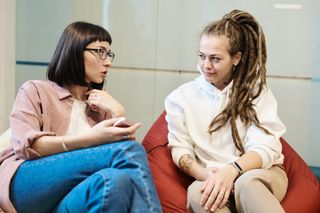Friends
How Can You Tell When You're Being Listened To?
Fake listening is all too common. Here's what the real thing looks like.
Posted March 6, 2020 Reviewed by Devon Frye

There's an epidemic of fake listening raging through our society, brought on by the pace of life, the deluge of information, and the need to keep up with virtual inputs rather than the person in front of us. It's frustrating—and it's all the more reason to celebrate real listening and connection when it does happen.
How can you tell when you’re being listened to? Given that many of our interactions now fall short of the human mark, how do you know for certain—in body language terms—when you’ve connected with someone?
Begin by understanding how truly miraculous a real human conversation is. We start learning them in the crib. Our parents—especially the helicopter variety—put in hundreds of hours, maybe thousands, cooing, smiling, prodding, winking, nodding, tickling, baby-talking, singing, and so on at us. And they do so with, at first, an astonishingly small return. One random smile back from the baby, one moment of eye contact, one gurgle, sets off a tsunami of exclamations of delight, imitations, and further attempts to turn us into Oxford debaters before we even know how to speak.
It’s very hard work to learn human conversation. Even after a year of devoted efforts on the part of parents, family friends, grandparents, caregivers, and other assorted participants, our abilities are typically limited to eye contact and a few words.
Slowly, we start to get the hang of it. Once school begins, and we are forcibly confronted with the rather startling idea that other people our size deserve their moment in the sun too, we begin to take bigger and faster strides toward the goal: being able to have a lucid give-and-take conversation with another human being.
But any parent who has asked a child how his or her day went and received a monosyllabic grunt in response knows how spotty the early conversational record can be. In truth, it takes years, and a huge amount of mostly unconscious work, to master the delicate human art of conversation, with a sender, a receiver, a signal, and feedback—the complete loop of human connection.
Researchers who study conversation find that it requires a formidable array of facial, body, and gestural signals simply to exchange opinions on the weather. A conversation between two truly connected people—lovers, friends, colleagues—who are in sync is a beautiful thing to behold.
This dance of human connection consists of several stages of surprisingly complicated activities: proffers (conversational gambits), returns, mirroring, comprehension and incomprehension signs, anticipation, and handoffs.
People who are truly connected in conversation mirror each other’s behavior effortlessly and unconsciously. They face the same way, sit the same way, gesture the same way, and so on. But they do so in a synchronized, balanced way, with little interruption and cross-talk.
A good test of how connected you are with someone else: watch what happens when you move. Does the other person move with you? If so, it’s a good sign that you’re connected. If not, not so much.
We use these gestures to signal where we are in the give and take of speaking and listening, so that the other person can easily and smoothly take over the conversation. It’s an endlessly subtle game of ping-pong. These handoffs help ensure that both parties get their say, and there isn’t too much interrupting going on.
In the end, we humans desire connection and find its absence unpleasant and lonely—and all the stats show that loneliness is reaching epidemic proportions around the world. By paying attention to the signs of connection, you can send the right signals to the other people in your life and increase your connectedness.


